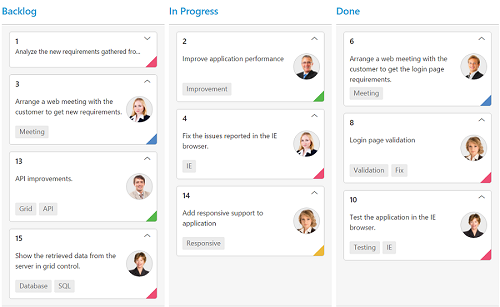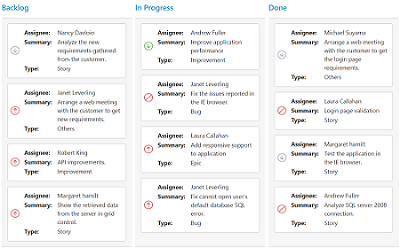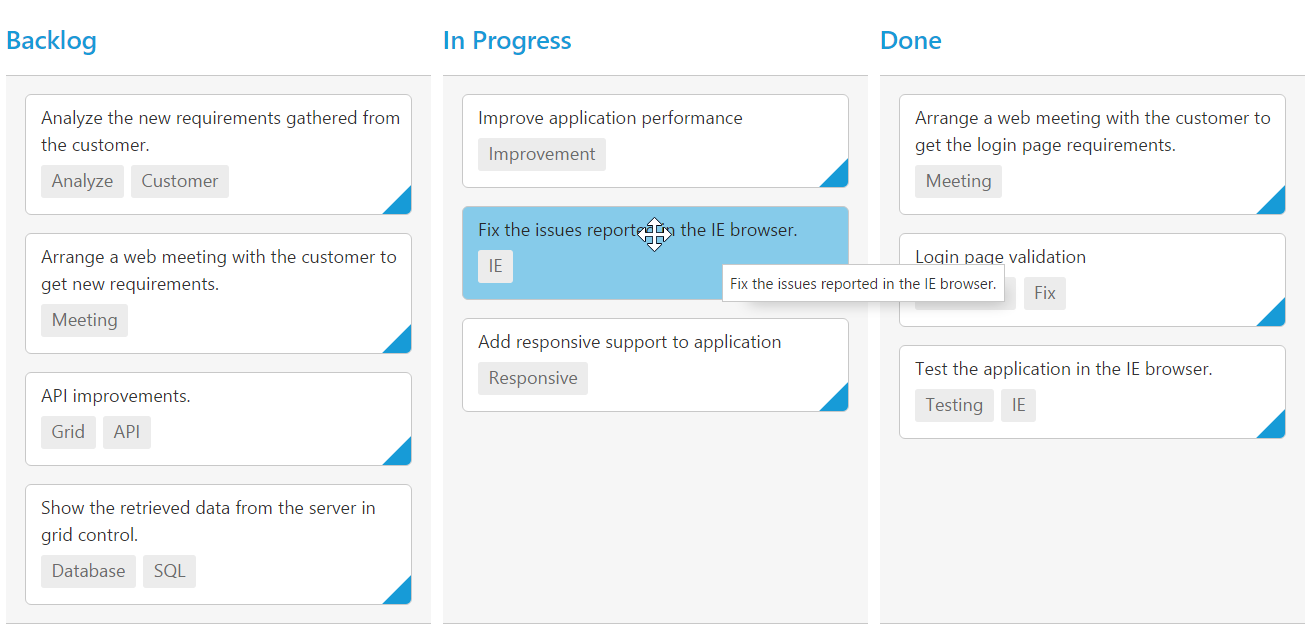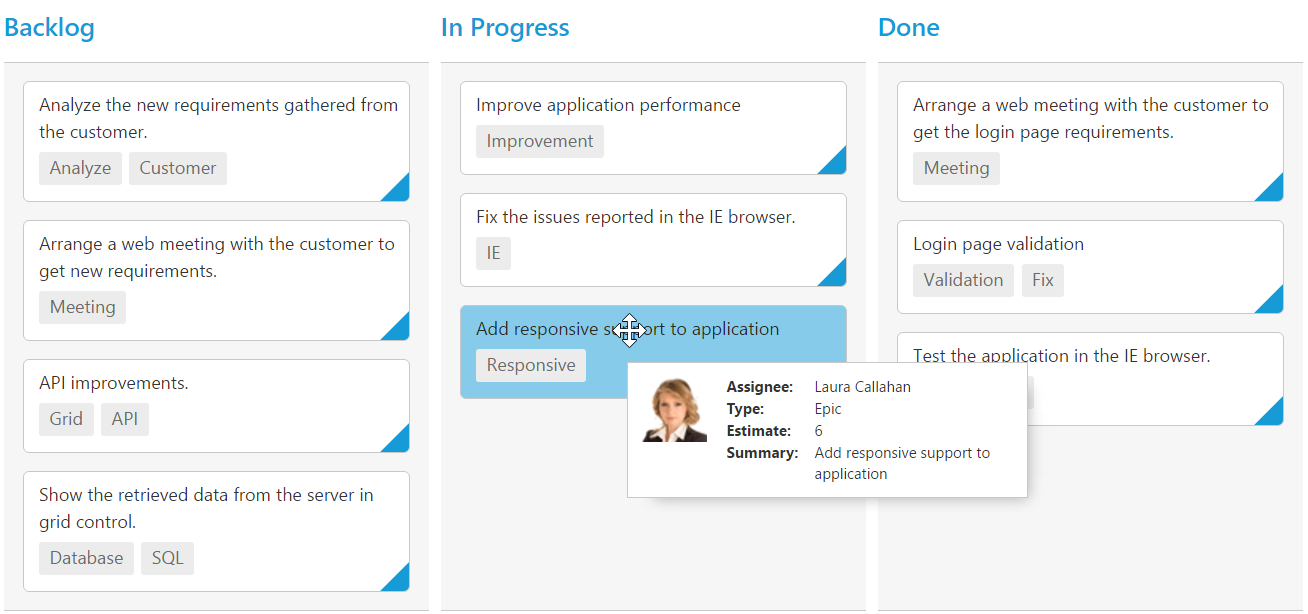Cards
29 May 201918 minutes to read
Customization
Cards can be customized with appropriate mapping fields from the database.
The following code example describes the above behavior.
<%@ page language="java" contentType="text/html; charset=ISO-8859-1"
pageEncoding="ISO-8859-1"%><%@ taglib prefix="ej" uri="/WEB-INF/EJ.tld" %><%@ page import="com.syncfusion.*" %><%@ page session="false" import="java.util.ArrayList" %><%@ page session="false" import="java.util.Iterator" %><%@ page session="false" import="java.util.HashMap" %><%@ page session="false" import="org.json.simple.parser.JSONParser" %><%@ page import="datasource.GetJsonData" %>
<body>
<div class="cols-sample-area"><%
GetJsonData obj=new GetJsonData();
Object data = obj.GetKanbanJson();
request.setAttribute("KanbanDataSource",data);
JSONParser parser = new JSONParser();
request.setAttribute("colorMap", parser.parse("{\"#ee4e75\": \"Bug,Story\",\"#57b94c\": \"Improvement\",\"#edba3c\": \"Epic\",\"#5187c6\": \"Others\"}"));
%>
<ej:kanban id="Kanban" keyField="Status" allowTitle="true" allowSelection="true" dataSource="${KanbanDataSource}">
<ej:kanban-fields content="Summary" priority="RankId" tag="Tags" primaryKey="Id" imageUrl="ImgUrl" color="Type"></ej:kanban-fields>
<ej:kanban-columns>
<ej:kanban-column headerText="Backlog" key="Open"></ej:kanban-column>
<ej:kanban-column headerText="In Progress" key="InProgress">
</ej:kanban-column>
<ej:kanban-column headerText="Done" key="Close"></ej:kanban-column>
</ej:kanban-columns>
<ej:kanban-cardSettings colorMapping="${colorMap}"></ej:kanban-cardSettings>
</ej:kanban>
</div>
</body>
</html>The following output is displayed as a result of the above code example.

Template
Templates are used to create custom card layout as per the user convenient. HTML templates can be specified in the template property of the cardSettings as an ID of the template’s HTML element.
The following code example describes the above behavior.
<%@ page language="java" contentType="text/html; charset=ISO-8859-1"
pageEncoding="ISO-8859-1"%><%@ taglib prefix="ej" uri="/WEB-INF/EJ.tld" %><%@ page import="com.syncfusion.*" %><%@ page session="false" import="java.util.ArrayList" %><%@ page session="false" import="java.util.Iterator" %><%@ page import="datasource.GetJsonData" %>
<body>
<div class="cols-sample-area">
<%
GetJsonData obj=new GetJsonData();
Object data = obj.GetKanbanJson();
request.setAttribute("KanbanDataSource",data);
%>
<ej:kanban id="Kanban" keyfield="Status" allowtitle="true" allowselection="true" datasource="${KanbanDataSource}">
<ej:kanban-fields content="Summary" primarykey="Id" imageurl="ImgUrl"></ej:kanban-fields>
<ej:kanban-columns>
<ej:kanban-column headertext="Backlog" key="Open"></ej:kanban-column>
<ej:kanban-column headertext="In Progress" key="InProgress"></ej:kanban-column>
<ej:kanban-column headertext="Testing" key="Testing"></ej:kanban-column>
</ej:kanban-columns>
<ej:kanban-cardsettings template="#cardtemplate"></ej:kanban-cardsettings>
</ej:kanban>
</div>
</body>
<style>
.e-templatetable {
width: 100%;
}
.details > table {
margin-left: 2px;
border-collapse: separate;
border-spacing: 2px;
width: 100%;
}
.details td {
vertical-align: top;
}
.details {
padding: 8px 8px 10px 0;
}
.photo {
padding: 8px 6px 10px 6px;
text-align: center;
}
.CardHeader {
font-weight: bolder;
padding-right: 10px;
}
</style>
<script id="cardtemplate" type="text/x-jsrender">
<table class="e-templatetable">
<colgroup>
<col width="10%">
<col width="90%">
</colgroup>
<tbody>
<tr>
<td class="photo">
<img src="Content/images/kanban/"{{:Priority}}.png">
</td>
<td class="details">
<table>
<colgroup>
<col width="10%">
<col width="90%">
</colgroup>
<tbody>
<tr>
<td class="CardHeader"> Assignee: </td>
<td>{{:Assignee}}</td>
</tr>
<tr>
<td class="CardHeader"> Summary: </td>
<td>{{:Summary}}</td>
</tr>
<tr>
<td class="CardHeader"> Type: </td>
<td>{{:Type}}</td>
</tr>
</tbody>
</table>
</td>
</tr>
</tbody>
</table>
</script>
</html>The following output is displayed as a result of the above code example.

Tooltip
You can enable HTML tooltip for Kanban card elements by setting enable property as true in tooltipSettings.
The following code example describes the above behavior.
<%@ page language="java" contentType="text/html; charset=ISO-8859-1"
pageEncoding="ISO-8859-1"%><%@ taglib prefix="ej" uri="/WEB-INF/EJ.tld" %><%@ page import="com.syncfusion.*" %><%@ page session="false" import="java.util.ArrayList" %><%@ page session="false" import="java.util.Iterator" %><%@ page session="false" import="java.util.HashMap" %><%@ page session="false" import="org.json.simple.parser.JSONParser" %><%@ page import="datasource.GetJsonData" %>
<body>
<div class="cols-sample-area"><%
GetJsonData obj=new GetJsonData();
Object data = obj.GetKanbanJson();
request.setAttribute("KanbanDataSource",data);
JSONParser parser = new JSONParser();
%>
<ej:kanban id="Kanban" keyField="Status" dataSource="${KanbanDataSource}">
<ej:kanban-fields content="Summary" tag="Tags" primaryKey="Id"></ej:kanban-fields>
<ej:kanban-columns>
<ej:kanban-column headerText="Backlog" key="Open"></ej:kanban-column>
<ej:kanban-column headerText="In Progress" key="InProgress">
</ej:kanban-column>
<ej:kanban-column headerText="Done" key="Close"></ej:kanban-column>
</ej:kanban-columns>
<ej:kanban-tooltipSettings enable="true"></ej:kanban-tooltipSettings>
</ej:kanban>
</div>
</body>
</html>The following output is displayed as a result of the above code example.

Template
By making use of template feature with tooltip, all the field names that are mapped from the dataSource can be accessed to define the template tooltip for card. The tooltipSettings.enable must be enabled first.
The following code example describes the tooltip template.
<%@ page language="java" contentType="text/html; charset=ISO-8859-1"
pageEncoding="ISO-8859-1"%><%@ taglib prefix="ej" uri="/WEB-INF/EJ.tld" %><%@ page import="com.syncfusion.*" %><%@ page session="false" import="java.util.ArrayList" %><%@ page session="false" import="java.util.Iterator" %><%@ page session="false" import="java.util.HashMap" %><%@ page session="false" import="org.json.simple.parser.JSONParser" %><%@ page import="datasource.GetJsonData" %>
<body>
<div class="cols-sample-area">
<%
GetJsonData obj=new GetJsonData();
Object data = obj.GetKanbanJson();
request.setAttribute("KanbanDataSource",data);
JSONParser parser = new JSONParser();
%>
<ej:kanban id="Kanban" keyfield="Status" datasource="${KanbanDataSource}">
<ej:kanban-fields content="Summary" tag="Tags" primarykey="Id"></ej:kanban-fields>
<ej:kanban-columns>
<ej:kanban-column headertext="Backlog" key="Open"></ej:kanban-column>
<ej:kanban-column headertext="In Progress" key="InProgress">
</ej:kanban-column>
<ej:kanban-column headertext="Done" key="Close"></ej:kanban-column>
</ej:kanban-columns>
<ej:kanban-tooltipsettings template="#tooltipTemp" enable="true"></ej:kanban-tooltipsettings>
</ej:kanban>
</div>
</body>
<script id="tooltipTemp" type="text/x-jsrender">
<div class='e-kanbantooltiptemplate'>
<table>
<tr>
<td class="photo">
<img src="{{:ImgUrl}}">
</td>
<td class="details">
<table>
<colgroup>
<col width="30%">
<col width="70%">
</colgroup>
<tbody>
<tr>
<td class="CardHeader">Assignee:</td>
<td>{{:Assignee}}</td>
</tr>
<tr>
<td class="CardHeader">Type:</td>
<td>{{:Type}}</td>
</tr>
<tr>
<td class="CardHeader">Estimate:</td>
<td>{{:Estimate}}</td>
</tr>
<tr>
<td class="CardHeader">Summary:</td>
<td>{{:Summary}}</td>
</tr>
</tbody>
</table>
</td>
</tr>
</table>
</div>
</script>
<style>
.details > table {
width: 100%;
margin-left: 2px;
border-collapse: separate;
border-spacing: 1px;
}
.e-kanbantooltiptemplate {
width: 250px;
padding: 3px;
}
.e-kanbantooltiptemplate > table {
width: 100%;
}
.e-kanbantooltiptemplate td {
vertical-align: top;
}
td.details {
padding-left: 10px;
}
.CardHeader {
font-weight: bolder;
}
</style>
</html>The following output is displayed as a result of the above code example.
